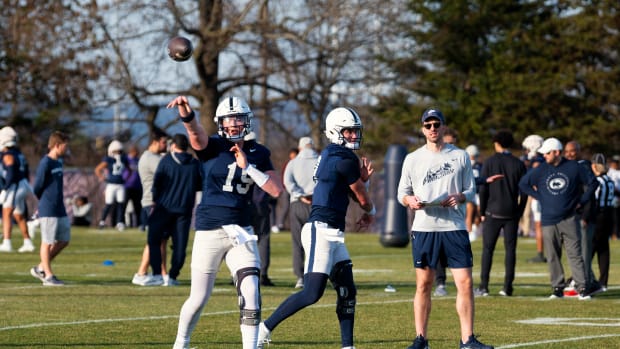Sources: Big 12 Could Add Four New Members By End of Next Week
The Big 12 is expanding and doing it at warp speed.
Less than six weeks after Texas and Oklahoma announced their impending departure to the SEC, the league is poised to add four new members in a process that could culminate in one week’s time. UCF, Houston, BYU and Cincinnati are expected to apply for Big 12 membership next week and then could be approved for admission in a meeting of Big 12 presidents Sept. 10, multiple sources tell Sports Illustrated.
The league has the eight votes needed for expansion.
In this scenario, the four teams will join the league by 2023 or, at the very latest, 2024, and may even compete alongside Oklahoma and Texas before those two powerhouses depart for the SEC, making for a couple of awkward seasons in a 14-team Big 12.
The timeline is fluid and has been described as optimistic, but not unrealistic. Big 12 commissioner Bob Bowlsby has even gone on site visits, most recently taking a trip to meet with Houston officials on Thursday.
“Now that the names [of the potential new additions] are out, I’d think that will expedite the process,” said one Big 12 source.
UCF, Houston and Cincinnati, the three American Athletic Conference members, are required to give 27-month notice to their league and pay a $10 million exit penalty. In the current timeline, the teams would give a 23-month notice and likely pay an increased exit fee. BYU is not a member of a conference in football, but must give the West Coast Conference notice for its other sports leaving the league.
The four new members are not expected to immediately get full distribution shares. However, their first-year shares in the Big 12 are expected to double if not triple their American distribution, which is around $6 million or $7 million.
A Big 12 source described the attraction of the prospective new additions being rooted in both TV market/audience and football relevancy. “Can you think of anybody that surpasses them in those areas?” the source asked. “All four have won in the last 10 years with multiple head coaches. That speaks to infrastructure and commitment.”
With the additions, the Big 12 will retain its status as an Autonomy 5 league, college football leaders believe. The NCAA granted autonomy powers in legislative matters to the Big Ten, SEC, Pac-12, ACC and Big 12, but the most important piece relates to the College Football Playoff. The Power 5 conferences hold lucrative bowl tie-ins as part of the CFP contract, which does not expire until after the 2025 season.
How the four new additions impact Texas and Oklahoma’s situation remains murky and may depend on the discretion of Big 12 commissioner Bob Bowlsby, who could strike a compromise at any time. The two schools are contractually bonded to the conference at least through the 2024 season by way of the league’s grant-of-rights agreement. Breaking that agreement early would mean owing the Big 12 large sums of money, potentially upwards of $100 million for each year remaining on the deal.
Separately, the two programs owe an exit penalty as part of a long-term agreement that conference members established several years ago. The exit fee is two years’ worth of gross revenue, which is expected to be around $80 million.
The decision for OU and Texas to leap to the SEC has sent shockwaves through the college sports landscape. The ripple effect of the moves could be long felt in the sport.
It has triggered another wave of realignment that, for now, seems destined to rearrange Group of 5 leagues (what, now, does the AAC do?).
It sent three Power 5 leagues—the ACC, Big Ten and Pac-12—scrambling to create a partnership, the Alliance, with the expressed mission that (1) they not poach one another’s conference members and (2) they schedule games against one another in the future.
And, finally, the OU/Texas move has delayed the approval of a 12-team CFP expansion model, which seemed destined for passage later this month in a meeting among Playoff executives. Certain college football leaders want to pause expansion approval in light of the realignment wave and give more opportunities to other media partners to bid on the product.
The CFP is seven years into a 12-year contract with ESPN. Leaders could renegotiate the deal before the contract ends, but that might mean ESPN gets the exclusive rights, which many executives are against. Or they could wait until the contract expires to open it up to the market in a way that allows more media partners to bid on portions of the 12-team contract, creating multi media owners to college football’s championship postseason.
There is a third option, but it is contingent on ESPN agreeing to break the contract early and allow a second media partner to bid on a portion of the expanded playoff.
In the meantime, will the AAC have a response to losing three of its richest members? A wave of realignment is now likely to hit the Group of 5 ranks. Some feel as if Conference USA is ripe for the plucking by the American. The Sun Belt also could try to make a power play to usurp the AAC as the country’s top G5 league. Meanwhile, the Mountain West Conference could emerge as a G5 winner if it keeps its membership intact.
More College Football Coverage:
• How Tony Elliott Went From Tire Guy to Clemson's OC
• 2021 Crystal Ball: Playoff Picks, Dark-Horse Predictions and More
• It May Be Time for Kirby Smart's Georgia to Finally Get Over the Hump
• The Most Intriguing People in Suits of the 2021 College Football Season





